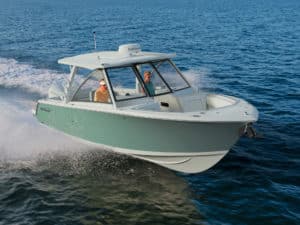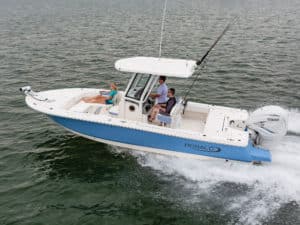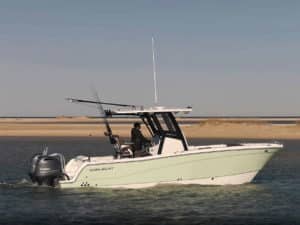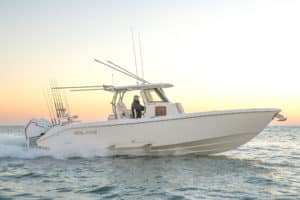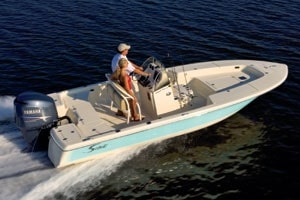
04scout
When I arrived at Miami’s Biscayne Bay Marriott in mid-February to board Scout’s new 221 Winyah Bay, company founder and president Steve Potts stood on the casting deck, proud as a new father, waiting to offer my tour. Potts designed this high-performance bay boat after spending countless hours fishing Florida’s inshore waters and talking to redfish-tournament captains about their wish lists.
Following the similar evolution of go-fast bass boats, Potts and his crew created a center-console vessel built for speed, range and fishability, and they added better rod storage, crafted a new leaning post, buttressed the livewell-pump system and fashioned an array of options to delight even the most particular captains.
Performance
After show and tell, we motored out of the slip and around the various vessels jockeying for position at this in-water Miami International Boat Show display. The wind blew 10 to 15 knots, and I was prepared for a high-speed, high-turbulence ride reminiscent of mornings spent racing across Lake Okeechobee, chine walking in a sparkled-up bass machine.
Potts gave the gas to our F250 Yamaha, and we popped up on plane in about 3 1/2 seconds, without the aid of trim tabs. Tabs come standard on the Tournament Edition we ran, but are considered an option for the 221.
Despite a messy 2-foot chop on Biscayne Bay, we flew along the tops of the waves feeling only an occasional bounce. We quickly topped 58 mph, but boat traffic and bridges in the crowded Miami waterways kept us from finding the boat’s upper speed range.
Tests by Yamaha experts show this boat hit 63 mph turning 5,900 rpm with half a tank of fuel, two people, two batteries and safety gear. Potts and others say they’ve reached 68. “With the right setup,” he says, “I think this could be a 70 mph boat.”
Fuel burn at top speed came in at 21.1 gph (2.99 mpg). At 4,000 rpm and 42 mph, the 221 burns 10.6 gph (3.98 mpg), and at 3,500 rpm and 35.6 mph, that rate drops to a miserly 7.2 gph and almost 5 mpg.
A hard-over turn from idle spun this boat up on a dime in very tight quarters. Turns to port and starboard at cruising speed take a little muscle, but the boat carves a sharp U bleeding off only a little speed.
Fishing
Scout built this boat to fish hard. Potts expanded the normal 4-inch-wide gunwales customary on many bay boats to almost 24 inches wide around the bow area – a walking-path-size gunwale. He also recessed the foredeck several inches deeper than the traditional 2 or 3 inches to give anglers a feeling of security while battling fish in pitching waves.
Formed into the gunwales along the foredeck, port and starboard locking rod holders with butt racks store 12 rods to 9 1/2 feet long. The depth and shape of the boxes and the racks allow anglers to remove rods more quickly when needed. Hatch lids are gasketed and equipped with hydraulic assist.
Six vertical rod holders flank the forward console seat. Four vertical holders come flush-mounted in the gunwales, and the standard aluminum leaning post hosts a rocket launcher for four more rods.
Our Tournament Edition 221 sported a T-top with rod holders, a performance leaning post (with one holder on either side) and two additional flush-mount holders on either side of the bow.
The optional performance leaning post tops this boat’s list of unique features and made Scout a finalist for a National Marine Manufacturers Association Innovation Award. With the bolster flipped up, the rounded seat cups the helmsman’s body as he stands. Flip the bolster down to sit. “Speed is important to fishing time,” Potts says. “But just as important as getting there before everyone else is getting there safely.”
The 221 comes with two lighted livewells aft (one 32-gallon release well with raw-water washdown centered in the aft deck and a 15-gallon well to starboard). Scout offers an optional port aft well and one under the forward console seat. The Tournament Edition features a redundant livewell-pump system designed to keep bait alive no matter what happens on the water.
Design and Construction The 221 features a padded hull with aggressive lifting strakes to bring the boat up out of the water quickly and reduce drag. The reverse transom features two internal knees for support and extra flotation to carry the weight of a heftier four-stroke engine.
Scout uses hand-laid woven roving and vinylester resin in the skin and integrates the composite stringer system into the all-composite transom. The company injects high-density foam in the voids between hull and deck and chemically bonds the two pieces rather than using rivets or screws.
The underside of every lid and hatch features a polished coat, and deck hardware fits flush, providing superior fit and finish. The starboard aft electrical-system compartment provides a color-coded chart for wiring.
Thoughtful details permeate this design. No wonder: The Winyah Bay was the founder’s self-described “pet project.”
| LOA…..22 ft. **BEAM…..8 ft. 6 in. HULL DRAFT…..12 in. DEADRISE…..18 deg.** WEIGHT…..1,940 lb **FUEL…..61 gal. MAX HP…..250 hp OB** MSRP…..$39,999 (w/ F150 Yamaha) | YAMAHA…..250 hp Four-stroke TYPE…..60 deg. V-6 **DISPL…..204.6 cid MAX RPM…..6,000 HP/LB RATIO…..0.42 FUEL SYSTEM…..EFI GEAR RATIO…..2:1 WEIGHT…..592 lb. ALT. OUTPUT…..45 amps MSRP…..$20,090** |
**Scout Boats / Summerville, South Carolina / 843-821-0068 / **www.scoutboats.com

